This is a Franka Rolfix II, a medium format folding camera made by Franka-Kamerawerk in Bayreuth, West Germany from about 1954 to 1957. The Rolfix II was one of the last in a long running series of Franka’s dual format folding cameras which first went into production in 1935. This camera natively shoots 6cm x 9cm images on 120 format roll film, but using a mask that was included with the camera when it was new, it could also shoot 6cm x 6cm images as well. An adjustable mask in the viewfinder allows for proper composition for both formats, and twin red windows on the back door allows you to see the proper exposure numbers. The Rolfix II, like most Franka cameras of it’s era was a well built, but relatively simple camera, with it’s best features being it’s German lenses and shutters.
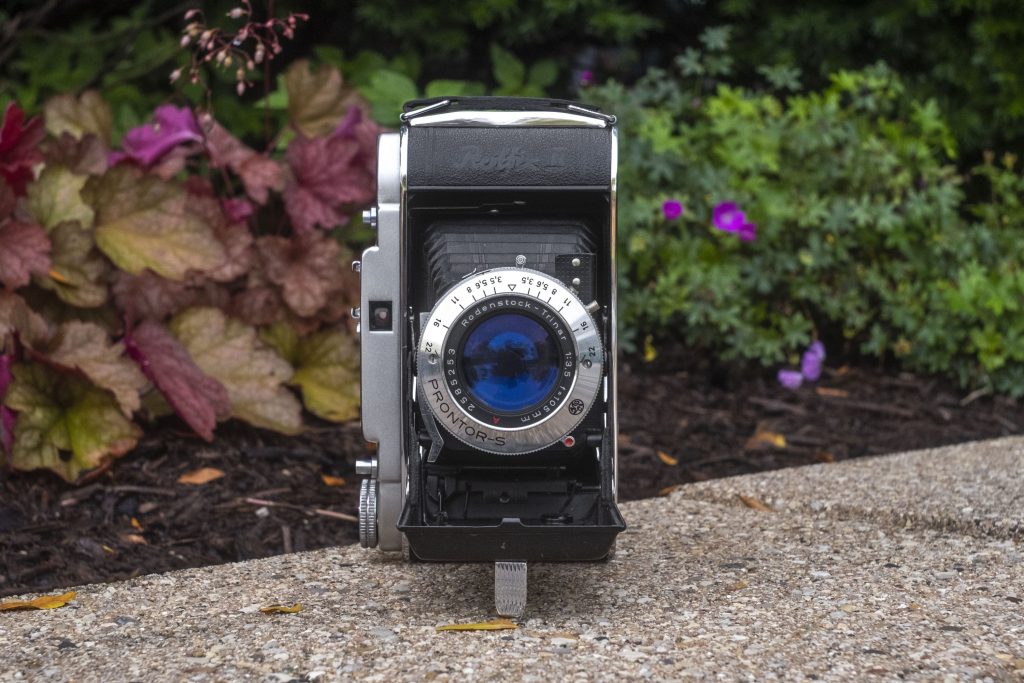 Film Type: 120 Roll Film (eight 6cm x 9cm or twelve 6cm x 6cm exposures per roll)
Film Type: 120 Roll Film (eight 6cm x 9cm or twelve 6cm x 6cm exposures per roll)
Lens: 105mm f/3.5 Rodenstock Trinar coated 3-elements in 3-groups
Focus: 1.5 meters to Infinity
Viewfinder: Scale Focus Optical
Shutter: Prontor-S Leaf
Speeds: B, 1 – 1/250 seconds
Exposure Meter: None
Battery: None
Flash Mount: Cold shoe and M and FP Flash Sync
Other Features: Self-Timer
Weight: 684 grams
Manual (similar model): https://www.butkus.org/chinon/rolfix/rolifix.htm
How these ratings work |
The Franka Rolfix II is an unassuming, yet very capable mid century folding camera. This isn’t a brand that stands out among other excellent German and Japanese camera makers, but with the f/3.5 Rodenstock Trinar, the Rolfix makes excellent images. Perhaps the best attribute of this camera is how inexpensive they can be found today. This is not a brand that many people specifically collect and with a feature set that was very common among many, very similar models, is a tremendous bargain today and one that is definitely worth the asking prices for them. | ||||||
| Images | Handling | Features | Viewfinder | Feel & Beauty | History | Age | |
| 2 | 1 | 1 | 1 | 2 | 1 | 30% | |
| Bonus | none | ||||||
| Final Score | 10.4 | ||||||
History
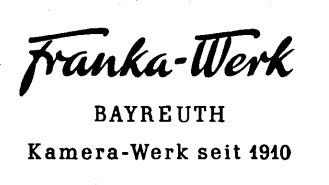 In the early 20th century, a huge amount of the German photographic industry revolved around the Dresden area. With over 20 different companies making cameras, lenses, and all manner of photographic gear, if you were looking to buy something to take pictures, with only a few exceptions, chances are you bought something from Dresden.
In the early 20th century, a huge amount of the German photographic industry revolved around the Dresden area. With over 20 different companies making cameras, lenses, and all manner of photographic gear, if you were looking to buy something to take pictures, with only a few exceptions, chances are you bought something from Dresden.
Of the non-Dresden camera companies there were some big names, Voigtländer boasted a history dating back to the 18th century in Braunschweig, and of course you had Leitz in Wetzlar making Leica cameras. Carl Zeiss was in the western half of Germany, but prior to 1926 was primarily an optics maker.
Beyond these three companies, a few smaller companies were spattered through western Germany. One of those companies was Franka, or more specifically, Franka-Kamerawerk. Franka’s history dates back to 1909 when Franz Vyskocil and his wife Leoni Vyskocil opened a small factory producing photographic gear in Stuttgart.
Over the course of the next three years, the company relocated to Bayreuth, a town in northwest Bavaria and changed it’s name a number of times, first to Vysko-Fabrik Franz Vyskocil, St. Georgen und Bayreuth, then Weigand & Vyskocil, then Frankonia-Kamerawerk, then Hogaschwerk, and finally to Franka-Kamerawerk.
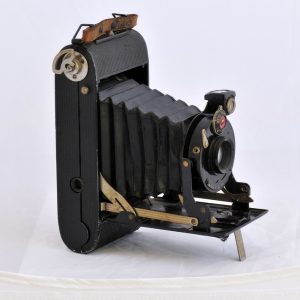
At this time, Franka made a variety of plate cameras, many of which were used in photo studios as house cameras. These early Franka cameras are rarely labeled and resembled plate cameras made by other companies of the era, making identifying an early Franka camera extremely difficult. As photography became more and more of an amateur hobby and no longer confined to a studio, in the 1930s, Franka started producing a wide range of very similar roll film models. A characteristic of many Franka roll film cameras was an optional mask which could be inserted into the film plane to reduce the format to a smaller size, allowing for more exposures on the same length of film.
Models such as the Rolf, Rolfix, and Bonafix started production around 1935 and offered a variety of good, but not great combinations of lenses and shutters. Compared to other roll film cameras being produced by companies like Zeiss-Ikon, Voigtländer, Welta, and Certo, Franka models would have been considered economy models. These cameras likely were sold to amateur photographers who needed a more affordable entry point into roll film cameras.
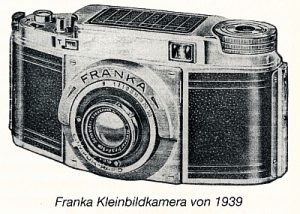
In 1939, the company started work on it’s first 35mm camera which the Internet calls the Kleinbildkamera which literally translates into 35mm camera. The camera never made it to production however, likely due to the beginning of the war. Whether the camera was shown in trade shows or in any publications is unclear, however a single drawing exists suggesting that at least one prototype was built.
Another eight years would pass before the world would see the first 35mm Franka camera when it was released in 1948. Very little is known about this camera as information is difficult to find online. The few photos I was able to find look identical to the 1939 drawing perhaps suggesting that the camera was completed, shelved, and then re-released 9 years later, or perhaps the 1939 date itself is incorrect. Whatever the case, in 1948 the first 35mm Franka camera was produced, but only for a very short time.
Instead, Franka-Kamerawerk continued to churn out a large number of Franka branded and white label roll film cameras. Prewar models like the Rolfix and Bonafix continued after the war with cosmetic updates such as chrome top and bottom plates, coated lenses, and more advanced shutters. Franka was now an OEM manufacturer for popular German retailers like Foto-Quelle and Porst who would rebrand their cameras with names like the Hapo and Revue.
The 1950s was the high point for Franka with distribution deals all over the world. Franka cameras were sold in Europe, Australia, and in the United States, no doubt taking advantage of the appeal of “German Cameras at an Affordable Price”.
In their 1955 camera catalog, the American retailer Montgomery Wards advertised the Franka Rolfix II as their advanced Franka camera with 105mm Rodenstock lens and Synchro-Compur shutter for $42.50, which when adjusted for inflation, compares to about $450 today, a non-inexpensive but certainly affordable price for someone wanting a good German camera without breaking the bank.
Franka cameras were a good value and well built, but did not appeal to professional photographers and didn’t appear in many professional publications, so finding contemporary reviews or advertisements for their cameras was difficult. Apart from the Montgomery Wards catalog above, I could not find any other English language reviews or ads for their cameras.
Franka’s peak came in 1958 when the company employed 154 people and had an annual output of 650,000 units. Things changed quickly however, as the shift away from roll film cameras to more popular 35mm SLR cameras and rangefinders and the rise in popularity of much less expensive Japanese cameras meant that Franka could not stay competitive.
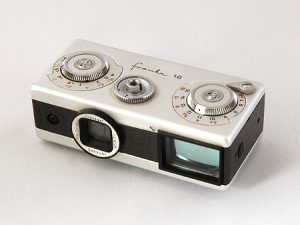
In late 1962, Franka was sold to Henry Wirgin likely based on the popularity of the Edixa 16, a subminiature 16mm camera that Wirgin had built by Franka in their Bayreuth factory. Wirgin had a strong interest in subminis at this time, so having a dedicated factory for this one model likely was appealing to him. It didn’t last long though, as in less than five years later, production in Bayreuth shut down completely and the last vestiges of Franka were shut down, never to produce another camera again.
Today, cameras like the Franka Rolfix fall into a large and vague category of what I would call “miscellaneous German cameras”. Collector sites like mine often spend a lot of time on models made by the big name companies, but the reality is, there were a HUGE number of brands and models produced throughout the early to mid 20th centuries by companies whose legacies are pretty much the same.
The Franka Rolfix doesn’t offer much that you couldn’t get by a huge number of these other cameras and as such are rarely desirable by collectors, but that doesn’t mean they’re not worth looking at. Like most of the other miscellaneous German cameras, they are almost always well built, and assuming they’ve been taken care of over the years, are still capable of making great photos. If you don’t care about labels and just want to shoot a folding camera, the Rolfix is definitely worth your effort.
My Thoughts
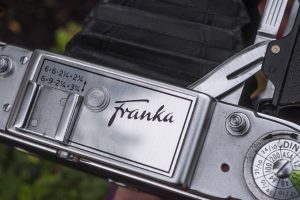
I have a strange relationship with 6×9 folding cameras. While most of the cameras in my collection capable of shooting those size images are certainly capable, a combination of often leaky bellows and a size that doesn’t translate well to discreet photography, I don’t often take out my Kodak Tourist or Zeiss-Ikon Cocarette.
When this Franka Rolfix II came my way in a lot of other cameras I picked up a year or so ago, I wasn’t all that thrilled to see it. Sure, it was in wonderful condition, and after my initial inspection, I mentally put this into my “flip on eBay pile”.
I don’t remember what reason I had the day I decided to load film into the Franka and take it for a spin as I am glad I did, as I really enjoyed shooting it. The camera wasn’t perfect, but it didn’t have to be.
For starters, Franka was never a top-tier camera maker. They were one of many German companies that were often good, but rarely great. Most of the company’s pre and post war output consisted of well made, all metal cameras, with good lenses by Rodenstock, Steinheil, Enna, or any other number of German companies not named Zeiss.
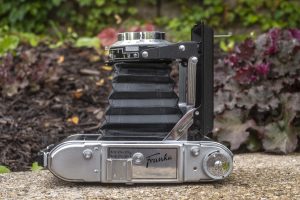
All cameras in the Rolfix series were dual format, meaning that with a baffle originally included with the camera when it was new, you could shoot both 6cm x 6cm shots in addition to the default 6cm x 9cm images. My particular example is missing the baffle, as I suspect most of the cameras found today have. If I had the baffle and wanted to use it, a switch on the top plate of the camera moves up and down to change the aspect ratio of the viewfinder, showing an appropriate square or rectangular image.
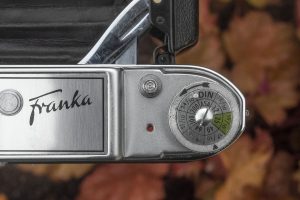
Off to the left is a small button that releases the front door, allowing you to fold open the camera. Behind the viewfinder switch is the accessory shoe on a chrome metal name plate.
To the right is the top plate shutter release, conveniently located within easy reach of the photographer’s right index finger, and a small double exposure prevention indicator below it. After exposing an image, the camera’s top plate shutter release becomes locked, not allowing you to fire the shutter again until after advancing the film. Doing so, removes the lock and this indicator turns red to let you know the that pressing the shutter release will fire the shutter…assuming you’ve remember to cock it first. Finally, there’s the film advance knob, with a film type reminder dial on top.
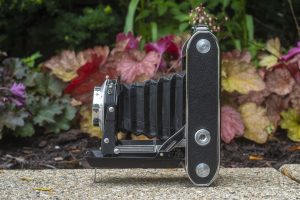
The camera’s other side has an offset 1/4″ tripod socket flanked by two chrome circles that don’t do anything.
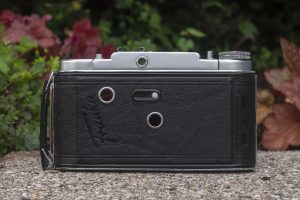
On the back of the camera there is a tiny circular eyepiece for the viewfinder on the top plate and on the door, two circular peep holes for reading the exposure numbers on the backing paper for both 6×6 and 6×9 images.
Both windows conveniently have a sliding door, which protects the windows from extra light which if exposed to direct sunlight can still damage film inside. Both doors are controlled by the same slider, and have printed reminders that the top window is for 6×9 and the middle window for 6×6.
Lastly, as was common with many German companies of the era, imprinted into the body covering off to the side is a script Franka logo, and “Made in Germany US-Zone” on the other. The body covering does not feel like real leather and is probably some kind of synthetic material, which thankfully on this example, has shown no signs of peeling.
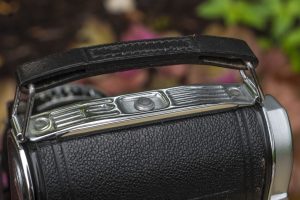
Opening the film compartment requires you to slide this little chrome switch on the side of the camera beneath the (probably not) leather carrying handle. Move the slider in the direction of the arrow and the hinged back swings open.
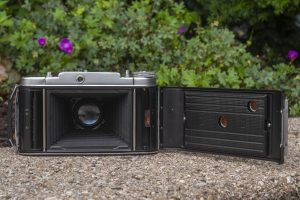
The film compartment is fairly typical of a camera from this era with a couple nice features. First is the film pressure plate which has both horizontal ribs and is textured with many little divots, both which help to reduce friction as film passes through the camera.
Film transports from left to right into removable spools. As with most roll film cameras, you should move an empty spool from the left to the right side before inserting a new roll of film. When new, the Rolfix II would have had a removable mask that fits into the film gate for exposing 6×6 images, but this one came to me without it.
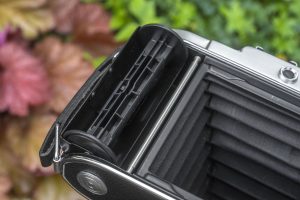
The nicest feature of the Franka Rolfix II are the hinged film holders on both the supply and take up sides of the film compartment. Loading a spool is very easy as all you need to do is swing out both sides, the take up side requires you to lift up on the film advance knob to get the spindle out of the way, and drop in both the film and the empty spool. Swing the holders back into position, and then stretch the backing paper across the film plane and attach the leader to the spool and you’re done. For what was back then a solid mid-level camera, this is a very nice feature that makes loading film much easier than on many other folding cameras.
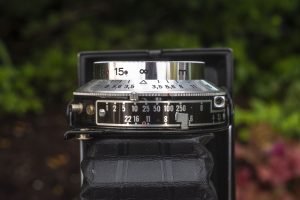
The Prontor-S shutter controls are marked with larger than usual numbers for shutter speeds, f/stops, and the focus scale. The aperture is controlled via a little lever nearest the bellows, and then shutter speeds with a ring around the perimeter of the shutter. A small shutter cocking lever is in between the near, between the markings for 1/10 and 1/100. This cocking lever is not at all coupled to the film transport, so you must remember to do this before pressing the top plate shutter release. Focus is controlled by rotating the entire front grouping. A scale from 1.5 meters to infinity requires 270 degrees from one end to the other. Finally, off to the right side of the shutter, facing up, is a threaded cable release socket. Not seen in this photo is a red tipped lever for the self-timer near the 5 o’clock position around the shutter.
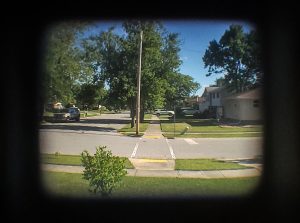
The top plate viewfinder is small, bur easy to see, even while wearing prescription glasses. The small lever on the top plate of the camera moves baffles on each side of the image to reduce a 6×9 rectangular image down to a square for 6×6 images. Although not showing any frame lines or anything of the camera’s other settings, the viewfinder is quite easy to use.
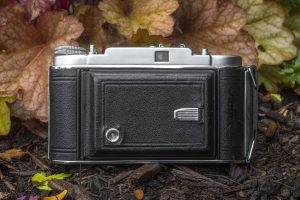
Lastly, with the camera folded shut, on the front of the door is the folding kickstand for supporting the camera on a flat surface with the camera erected, and a second 1/4″ tripod socket, for mounting the camera on a tripod in portrait orientation.
The Franka Rolfix II is certainly not a top of the line folding camera, but with it’s good lens and shutter, dual format, and convenient film loading system, you could certainly do a lot worse. This is an attractive and well built camera that despite my initial ambivalence, proved itself to be a worthy shooter. But how worthy?
My Results
Since loading up my first roll of Arista.Edu 400 black and white camera into the Franka, I loaded up two others. One was a fresh roll of Kodak Ektar 100, and the second was some Portra 160 NC. Unfortunately, I had issues developing both of the color rolls. I developed these during a time when I decided to try something different than my usual Unicolor kit and did one of those all in one color kits that claim to be able to do both C41 and ECN2 (motion picture film), and clearly they either aren’t very good, or I did not follow the instructions correctly as I had some really bizarre color shifts. Some images were so badly distorted, I didn’t want to share them here.
Continuing with my story of how this Franka Rolfix II came to me, my enjoyment of camera continued the more I used it. Here was a well built, no frills, 6×9 roll film camera that was easy to use, had a good lens, and would take great images. I thought that perhaps this could be a regular go-to camera for when I wanted to shoot 6×9 and didn’t have the room for bulkier cameras like the Kodak Medalist…then I saw the pictures.
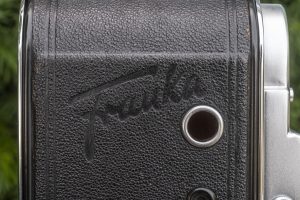
Before I get to that though, I should point out that any time you use a half century or more camera that likely has not been used or serviced in decades, you have to take any faults it might have with a grain of salt. It is completely unreasonable for anyone to think that they can go to an estate sale or on eBay and buy an old camera, take it home, load it up with film, and expect it to work like new.
When I saw the results from the first rolls of film shot in the Franka, I was dismayed that either my C41 chemistry had gone bad, or I fundamentally forgot how to develop film as the images had strange color casts all over them. Making matters worse, many of the worst images were shot on a summer vacation I took out east last year of cool places like Gettysburg, PA and Washington DC.
As I shot my next roll of black and white film, it also became apparent that I had some sort of film flatness issue, possibly due to the pressure plate, or perhaps the front lens standard was not perfectly parallel with the film plane. You can see this in several images above where one half of an image (usually at infinity) is strangely out of focus from the other half.
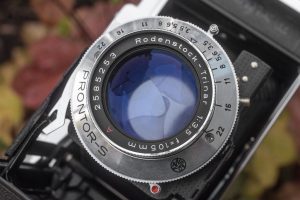
Putting aside all technical and development failures however, I still feel as though I used this camera enough to comment on it’s performance and use, and for that, I’ll start out by declaring this to be a pretty nice camera. For starters, the f/3.5 Rodenstock Trinar is pretty good. Had it not had the prefix “tri” in it’s name, I would have really wondered if this was a 4-element, possibly Tessar based design as the images are very sharp with only the slightest bit of softness in the corners. A triplet can usually do a pretty good job on a 6×6 camera, but adding in the extra coverage necessary to extend out to a the corners on 6×9 is a tough challenge.
The camera’s various controls are easy to reach and understand. Assuming you’ve used a medium format folding camera before, there are no surprises here. The top plate shutter release is very conveniently located and although requires a good amount of pressure, isn’t difficult to do, and avoids many of the pitfalls of other folding cameras with top plate shutter releases where you can feel every kink and groan of the metal linkage going through the plate, around the bellows, and to the shutter itself.
Although lacking a rangefinder, the scale focus viewfinder is large and bright enough to get the job done. I don’t seem to have the difficulty that other shooters of vintage cameras do when estimating distance as I had no problems getting accurate focus, even when not at infinity.
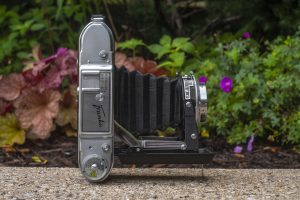
Loading and removing film from the Franka is surprisingly well thought out, especially for what was an economic camera. I’ve shot many more advanced cameras where I had to fight with the spool flanges trying to get them seated just in the right orientation, or tugging at them with my fingernails to get them out after I completed a roll. Not so with the Rolfix, simply open the door, pull out the wind knob, and then swing out both the supply and take up spools and you’re done. Kodak could have learned a thing or two from this camera on many of their 620 and 616 folding cameras of the same era.
Finally, the large diameter of the controls around the Prontor-S were easy to change and see what setting I had the camera on. I’ve always preferred leaf shutter cameras that show you the shutter speed and f/stop scales on the top of the shutter, rather than the front.
As a straight forward mid century 6×9 folding camera, there’s almost nothing not to like about the Franka Rolfix II. The camera looks great, is easy to use, and has a really nice lens. Of course mine had some technical issues, and I completely botched the development, but I cannot blame the camera on that. Back in the era that this camera was a current model, I am convinced that anyone willing to take a chance on one, was likely very pleased.
Is there enough that’s cool or unique about this camera for you to give it a try? I can’t be certain, but I can guarantee you that of all the countless similar cameras that use the same type of film and make the same size exposures as this one, you could do a LOT worse. If it was economically feasible to send this camera in for repair, I actually think it’s worth it, and maybe someday I might actually do it, but for now, this one will remain a proud member of my permanent collection.
Related Posts You Might Enjoy
External Links
http://camera-wiki.org/wiki/Rolfix
http://www.jnoir.eu/en/cameras/franka/rolfix/

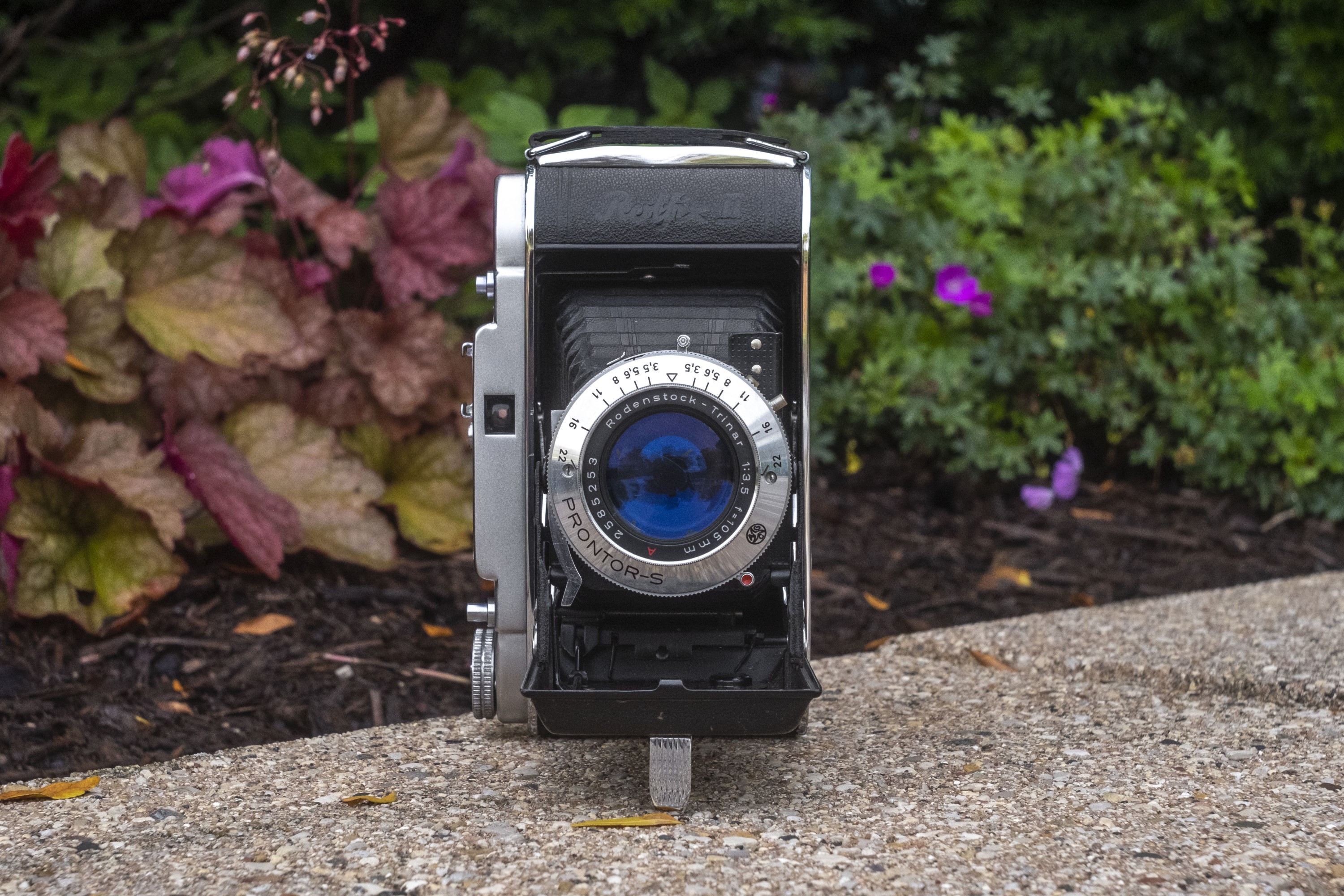
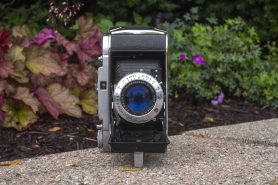
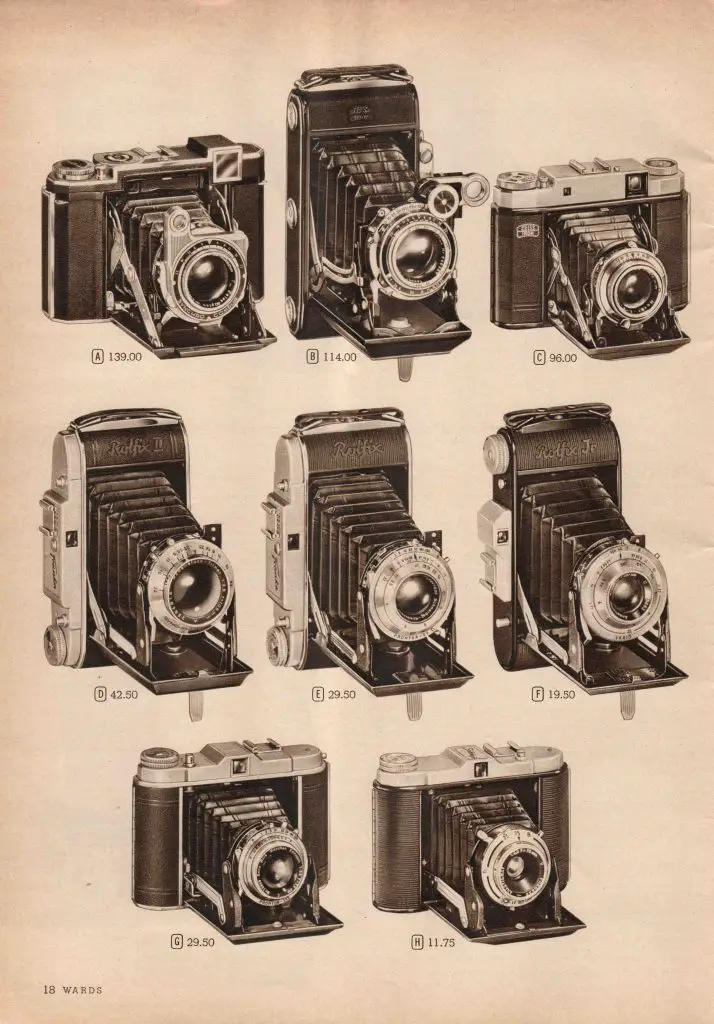
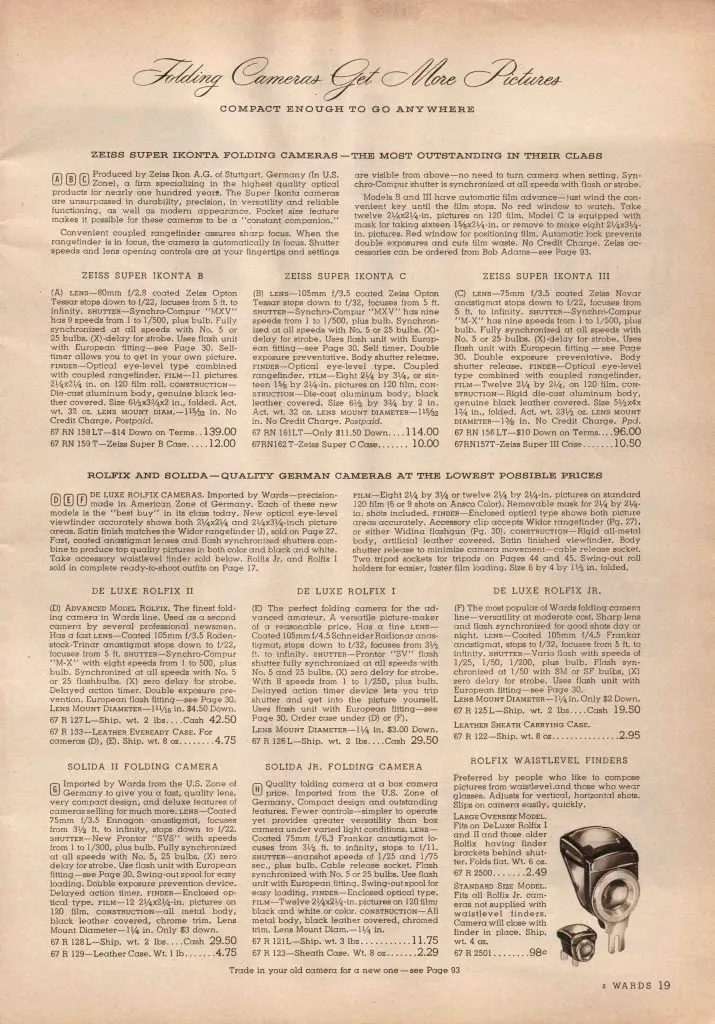














Hey Mike, I think this sentence is missing a crucial “not” – “As a straight forward mid century 6×9 folding camera, there’s almost nothing to like about the Franka Rolfix II.”
Oh my! You’re right! I have made the change and fired my proofreader! 🙂
Pretty nice results, even with the ‘faults’
Nice review; it echoes my thoughts having owned an older model Rolfix (album of photos here: https://www.flickr.com/photos/hsandler/albums/72157691682603795 ).
The one I had was post-war, as it was marked “US Zone”, though it pre-dated the integral top-deck viewfinder. It came with a Schneider Radionar f4.5 lens, which was pretty good, but uncoated I think. The body covering was that synthetic corduroy fabric. I no longer have the camera, but I think the mask (which was missing of course) and the second red window on mine were for 6×4.5, judging from the extra framelines in the wire frame finder.
I do think there were some that did 6×6 and 4.5×6 too. The one definitely is both 6×9 and 6×6. Whichever ones you use however, they’re going to be good shooters!